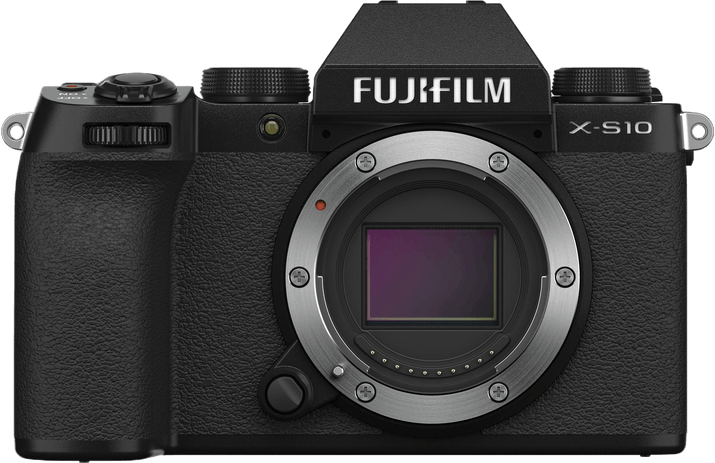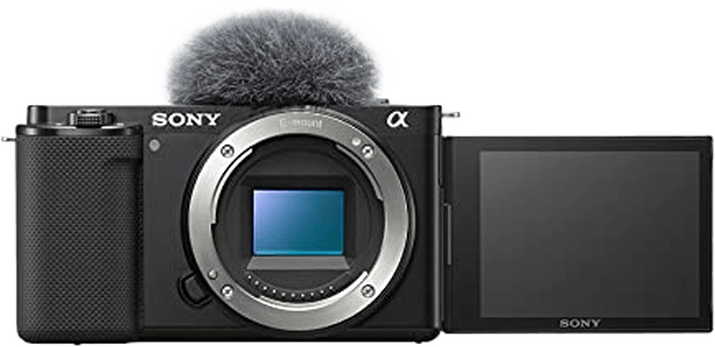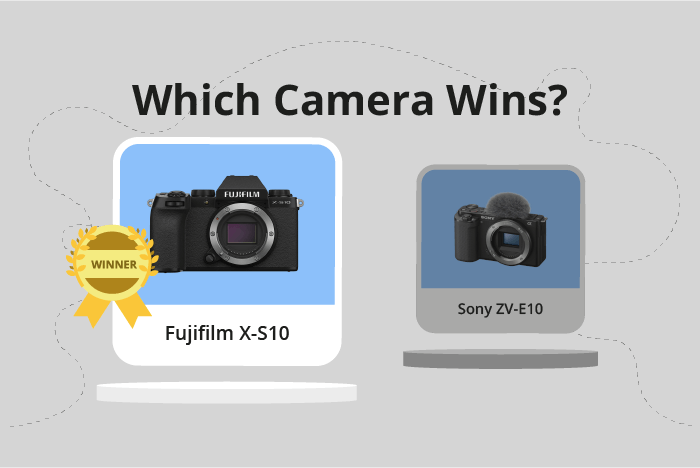Fujifilm X-S10 vs Sony ZV-E10 Comparison
Fujifilm X-S10

Sony ZV-E10

The Fujifilm X-S10 takes the lead with a score of 69/100, surpassing the Sony ZV-E10 by 4 points. Both cameras are mirrorless and were released in 2020 and 2021, respectively. They share similarities in launch price, with the Fujifilm X-S10 priced at $999 and the Sony ZV-E10 at $700.
The Fujifilm X-S10 stands out with its larger size, measuring 126 x 85 x 65mm and weighing 465g (1.03lbs). This heftier build may offer improved ergonomics and stability for photographers. On the other hand, the Sony ZV-E10 has a more compact design, measuring 115 x 64 x 45mm and weighing 343g (0.76lbs). This lighter and smaller form factor makes it more portable and travel-friendly.
Each camera has its unique advantages, with the Fujifilm X-S10 offering better handling and the Sony ZV-E10 providing greater portability. Ultimately, the choice between these two cameras depends on the photographer’s preferences and needs.
Fujifilm X-S10 vs Sony ZV-E10 Overview and Optics
The Fujifilm X-S10 outperforms the Sony ZV-E10 in optics with a score of 72/100 compared to 69/100. Both cameras share several specifications, including a CMOS sensor, APS-C sensor size, and respective lens mounts (Fujifilm X for X-S10 and Sony E for ZV-E10). However, there are key differences that make the X-S10 a better choice in terms of optics.
The Fujifilm X-S10 has a higher megapixel count at 26, compared to the Sony ZV-E10’s 24 megapixels. This results in higher image resolution and better overall image quality. Additionally, the X-S10 has a faster shooting speed of 20 frames per second, almost double the ZV-E10’s 11 frames per second. This allows for capturing fast-moving subjects with greater ease and precision. The X-S10 also features image stabilization, which the ZV-E10 lacks. This makes the X-S10 more suitable for handheld photography and videography, as it can compensate for camera shake and produce sharper images.
On the other hand, the Sony ZV-E10 has a higher DXOMARK sensor score of 86, indicating a potentially better image quality in certain conditions. However, it is important to note that DXOMARK does not score Fujifilm cameras, so a direct comparison cannot be made. The ZV-E10 also has a different aspect ratio of 4:3, while the X-S10 uses a 3:2 aspect ratio. This may be a preference for some users, but it does not necessarily make the ZV-E10 a better camera in terms of optics.
Considering these factors, the Fujifilm X-S10 is a superior choice for those prioritizing optics. Its higher megapixel count, faster shooting speed, and image stabilization provide a more versatile and capable camera for various shooting situations. While the Sony ZV-E10 does have some advantages, they are not significant enough to outweigh the benefits of the X-S10’s superior optics.
Fujifilm X-S10 vs Sony ZV-E10 Video Performance
The Fujifilm X-S10 and Sony ZV-E10 both receive a video score of 91 out of 100, making them equally strong contenders in the video capabilities department. They share some key specs, such as 4K max video resolution and built-in time-lapse functionality, which cater to the needs of many videographers.
However, the Fujifilm X-S10 has an edge in two areas. First, it offers a max video dimension of 4096 x 2160, which is higher than the Sony ZV-E10’s 3840 x 1920. This difference means that the X-S10 can capture more details and produce sharper videos. Second, the X-S10 boasts a max video frame rate of 240fps, double the ZV-E10’s 120fps. This allows the X-S10 to record smoother slow-motion footage, giving users more creative options when filming.
On the other hand, the Sony ZV-E10 does not have any significant advantages over the Fujifilm X-S10 in terms of video capabilities. Both cameras are on par with each other, sharing the same video score and most specs. As a result, the Fujifilm X-S10 emerges as the better option for those prioritizing video performance, thanks to its higher max video dimensions and frame rate.
When choosing between the Fujifilm X-S10 and the Sony ZV-E10, videographers should consider the X-S10 for its superior video dimensions and frame rate. However, the ZV-E10 remains a solid choice for those who do not require the additional benefits offered by the X-S10, as they share the same video score and core specs. Ultimately, the decision depends on the specific needs and preferences of the user.
Fujifilm X-S10 vs Sony ZV-E10 Features and Benefits
The Fujifilm X-S10 wins the feature comparison with a score of 70/100, while the Sony ZV-E10 scores 68/100. Both cameras share common specifications, such as a 3-inch screen size, touchscreen functionality, flip screen, and Bluetooth connectivity. Neither camera has GPS.
The Fujifilm X-S10 surpasses the Sony ZV-E10 in screen resolution, boasting 1,040,000 dots compared to the ZV-E10’s 920,000 dots. This higher resolution provides a clearer and more detailed display for users. Despite this advantage, the X-S10 does not have WIFI capabilities, unlike the Sony ZV-E10.
The Sony ZV-E10, despite its slightly lower feature score, offers WIFI connectivity, allowing users to transfer files and remotely control the camera with ease. This feature can be beneficial for those who prioritize convenience and wireless connectivity in their photography and videography.
Comparing the two cameras, the Fujifilm X-S10’s higher screen resolution makes it a better option for those who value image clarity and detail on their camera’s display. On the other hand, the Sony ZV-E10’s WIFI capabilities cater to users who prefer wireless connectivity and ease of file transfer. Both cameras have their strengths, and the choice between them ultimately depends on the user’s priorities and preferences.
Fujifilm X-S10 vs Sony ZV-E10 Storage and Battery
The Fujifilm X-S10 outperforms the Sony ZV-E10 in storage and battery, with a score of 35/100 compared to the Sony’s 24/100. Both cameras share similar storage specifications, having a single memory card slot and accepting SD/SDHC/SDXC cards. However, the Sony ZV-E10 also supports Memory Stick Pro Duo cards.
The Fujifilm X-S10’s battery life is shorter at 325 shots, while the Sony ZV-E10 lasts for 440 shots. Despite this, the X-S10 has an advantage with its USB charging capability, which the ZV-E10 lacks. This feature adds convenience and flexibility for users on-the-go.
While the Sony ZV-E10 has longer battery life, the Fujifilm X-S10’s USB charging functionality makes it a more practical choice for those who prioritize convenience. The X-S10’s higher score in storage and battery reflects its overall superiority in this aspect.
Fujifilm X-S10 vs Sony ZV-E10 – Our Verdict
Are you still undecided about which camera is right for you? Have a look at these popular comparisons that feature the Fujifilm X-S10 or the Sony ZV-E10:

